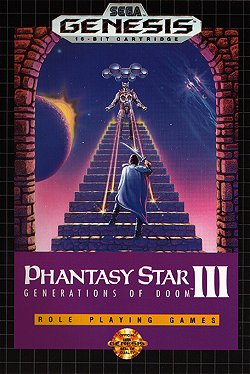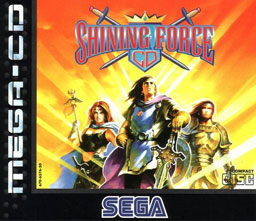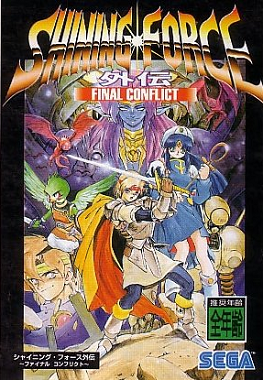
Phantasy Star is a role-playing video game (RPG) developed by Sega and released for the Master System in 1987. One of the earliest Japanese RPGs for consoles, Phantasy Star tells the story of Alis on her journey to defeat the evil ruler of her star system, King Lassic, after her brother dies at his hands. She traverses between planets, gathering a party of fighters and collecting the items she needs to avenge her brother's death and return peace to the star system. The gameplay features traditional Japanese RPG elements including random encounters and experience points. All the characters have predefined personalities and abilities, a unique element compared to the customizable characters of other RPGs of the era.

Phantasy Star II is a science fantasy role-playing video game developed and published by Sega for the Sega Genesis. It was released in Japan in 1989, North America in 1990, and in Europe in 1990. It was later ported to a variety of different platforms. An updated remake, Phantasy Star Generation 2, was released for the PlayStation 2 in 2005 in Japan.
The Shining series is a brand of role-playing video games published by Sega, who owns the property. The first game, Shining in the Darkness, was a first-person dungeon crawler with randomly encountered, turn-based battles. The next game released in the series was Shining Force, which was a turn-based strategy style tactical role-playing game with battle scenes acted out with sprites. Other directions include Shining Soul, a dungeon crawl action role-playing game with roguelike elements, and a number of traditional Japanese role-playing games. Shining Resonance Refrain was released on PlayStation 4, Xbox One, Steam PC and Nintendo Switch worldwide across 2018.

Shining in the Darkness, released as Shining and the Darkness in Japan, is a 1991 role-playing video game for the Mega Drive/Genesis video game console. It was one of the first role-playing games released for the system, and was the first in the Shining series.
Tactical role-playing games, also known as strategy role-playing games and in Japan as simulation RPGs, are a video game genre that combines core elements of role-playing video games with those of tactical strategy video games. The formats of tactical RPGs are much like traditional tabletop role-playing games and strategy games in appearance, pacing, and rule structure. Likewise, early tabletop role-playing games are descended from skirmish wargames such as Chainmail, which were primarily concerned with combat.

Phantasy Star III: Generations of Doom is a role-playing video game developed and published by Sega. It was released for the Sega Genesis in Japan in April 1990 and worldwide the following year. It is the third game in the original Phantasy Star series, and is a distant sequel to the previous games. However, gameplay is similar to the previous games, with turn-based combat and random encounters. Players explore various overworld maps and dungeons in order to progress through the game. It was later re-released on the Virtual Console and on retro collections such as the Phantasy Star Collection, Sega Genesis Collection, and Sonic's Ultimate Genesis Collection.

Lunar: The Silver Star is a role-playing video game developed by Game Arts in association with Studio Alex for the Sega/Mega-CD, originally published by Game Arts and released in Japan in 1992. After a successful release, the game was translated and localized by Working Designs for release in North America the following year.

Streets of Rage 2, known as Bare Knuckle II In Japan, is a 1992 side-scrolling beat 'em up video game published by Sega for the Genesis/Mega Drive. A sequel to Streets of Rage (1991), the characters Axel Stone and Blaze Fielding return while the game also introduces two new characters: Max Thunder, and Eddie "Skate" Hunter, the younger brother of Adam Hunter from the first game.

Shining Force II is a tactical role-playing game for the Mega Drive/Genesis console developed by Sonic! Software Planning and published by Sega in 1993. Its storyline is not directly connected to the original Shining Force, although a Game Gear title Shining Force Gaiden: Final Conflict links the two games' plots.

Shining Force III is a tactical role-playing game released for the Sega Saturn. In Japan, Shining Force III was an episodic video game with three discs - Scenario 1, Scenario 2, and Scenario 3 - released individually across late 1997 and 1998. Each scenario utilizes the same core gameplay mechanics, but follows a different character's perspective of the overarching narrative in a shared game world. In North America and Europe, only the first entry, Scenario 1, was translated into English, and was simply titled Shining Force III for its release in mid-1998.
Phantasy Star is a series of console role-playing video games and other supplementary media created by Sega. The series debuted in 1987 on the Master System with Phantasy Star, and continues into the present with Phantasy Star Online 2 and other extensions of the Phantasy Star Online sub-series. Each of the games in the series features a science fantasy setting featuring a cross-genre combination of magic and technology.

Double Dragon is a 1987 beat 'em up video game developed by Technōs Japan and distributed by Taito for arcades across Asia, North America and Europe. It is the first title in the Double Dragon franchise. The game's development was led by Yoshihisa Kishimoto, and it is a spiritual and technological successor to Technos' earlier beat 'em up, Nekketsu Kōha Kunio-kun (1986), released outside of Japan by Taito as Renegade; Kishimoto originally envisioned it as a direct sequel and part of the Kunio-kun series, before making it a new game with a different cast and setting.

Lufia & the Fortress of Doom, known as Estpolis Denki in Japan, is a role-playing video game developed by Neverland and published by Taito in 1993, for the Super Nintendo Entertainment System. It is the first title in the Lufia series of video games and the only game from the series released under the Taito label in North America.

Shining Force CD (シャイニングフォースCD) is a 1994 strategy role-playing game developed by Sonic! Software Planning for the Sega CD, and a remake of the games Shining Force Gaiden and Shining Force Gaiden II that were originally for the Game Gear. Although the game went largely unnoticed upon release in 1995, it has gained a cult following and is considered to be one of the best titles released for the Sega CD platform.

Panzer Dragoon Saga, known in Japan as Azel: Panzer Dragoon RPG, is a 1998 role-playing video game (RPG) developed by Team Andromeda and published by Sega for the Sega Saturn. The third entry in the Panzer Dragoon series, it replaced the rail shooter gameplay of the previous games with RPG elements such as random encounters, semi-turn-based battles and free-roaming exploration. The player controls Edge, a young mercenary who rides a dragon and encounters a mysterious girl from a vanished civilization.

Shining Wisdom is an action-adventure game developed by Sonic! Software Planning and Camelot Software Planning and published by Sega for the Sega Saturn. It was the last game in the Shining series to be developed for the Sega Genesis/Mega Drive but was reworked for the Saturn late in development. Because of this, it is more typical of the Genesis library than the Saturn library in its basic approach, rendering characters and backgrounds exclusively in 2D and utilizing mechanics which mostly follow the rules of a two-dimensional world. This approach was seen as dated by critics, and it was met with mixed reviews, with some seeing it as a decent holdover title due to its massive length.

Shining Force Gaiden: Final Conflict is a 1995 tactical role-playing game for the Game Gear, taking place between the games Shining Force and Shining Force II. It was released after both games, with the intention of connecting their plots. Despite its name, it is not directly story-related to Shining Force Gaiden or Shining Force Gaiden II, also released for Game Gear. Unlike most of its predecessors, the game was never released outside Japan. English patches have been created by fans for players who cannot speak Japanese.

Golden Axe II is a side-scrolling beat 'em up video game developed and published by Sega, first released on the Sega Mega Drive in December 1991. It is the home console sequel to the popular game Golden Axe, marking the second game in the series, though the arcade did see a sequel of its own in 1992, titled Golden Axe: The Revenge of Death Adder. Golden Axe II was only released on the Mega Drive, while the original was released on many other platforms. The game later appeared in Sonic's Ultimate Genesis Collection for Xbox 360 and PlayStation 3, as an iOS app on iTunes, and on the Nintendo Switch Online + Expansion Pack.

Shining Soul is an action role-playing game for the Game Boy Advance. It is part of the Shining series. Shining Soul is a reboot of the Shining series. The game was followed by a sequel, Shining Soul II, in 2003. Both games were re-released in Japan in early 2006 as part of the Game Boy Advance "Value Selection."

Shining Force: The Sword of Hajya is a 1993 tactical role-playing game for the Sega Game Gear.



















